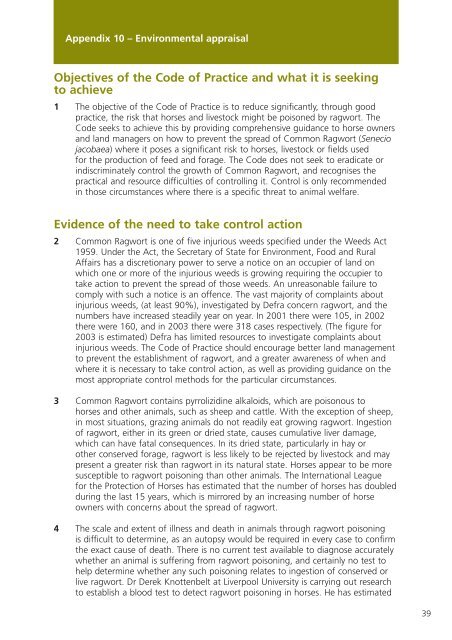code of practice on hopw to prevent the spread of ragwort - Defra
code of practice on hopw to prevent the spread of ragwort - Defra
code of practice on hopw to prevent the spread of ragwort - Defra
You also want an ePaper? Increase the reach of your titles
YUMPU automatically turns print PDFs into web optimized ePapers that Google loves.
Appendix 10 – Envir<strong>on</strong>mental appraisal<br />
Objectives <str<strong>on</strong>g>of</str<strong>on</strong>g> <strong>the</strong> Code <str<strong>on</strong>g>of</str<strong>on</strong>g> Practice and what it is seeking<br />
<strong>to</strong> achieve<br />
1 The objective <str<strong>on</strong>g>of</str<strong>on</strong>g> <strong>the</strong> Code <str<strong>on</strong>g>of</str<strong>on</strong>g> Practice is <strong>to</strong> reduce significantly, through good<br />
<str<strong>on</strong>g>practice</str<strong>on</strong>g>, <strong>the</strong> risk that horses and lives<strong>to</strong>ck might be pois<strong>on</strong>ed by <strong>ragwort</strong>. The<br />
Code seeks <strong>to</strong> achieve this by providing comprehensive guidance <strong>to</strong> horse owners<br />
and land managers <strong>on</strong> how <strong>to</strong> <strong>prevent</strong> <strong>the</strong> <strong>spread</strong> <str<strong>on</strong>g>of</str<strong>on</strong>g> Comm<strong>on</strong> Ragwort (Senecio<br />
jacobaea) where it poses a significant risk <strong>to</strong> horses, lives<strong>to</strong>ck or fields used<br />
for <strong>the</strong> producti<strong>on</strong> <str<strong>on</strong>g>of</str<strong>on</strong>g> feed and forage. The Code does not seek <strong>to</strong> eradicate or<br />
indiscriminately c<strong>on</strong>trol <strong>the</strong> growth <str<strong>on</strong>g>of</str<strong>on</strong>g> Comm<strong>on</strong> Ragwort, and recognises <strong>the</strong><br />
practical and resource difficulties <str<strong>on</strong>g>of</str<strong>on</strong>g> c<strong>on</strong>trolling it. C<strong>on</strong>trol is <strong>on</strong>ly recommended<br />
in those circumstances where <strong>the</strong>re is a specific threat <strong>to</strong> animal welfare.<br />
Evidence <str<strong>on</strong>g>of</str<strong>on</strong>g> <strong>the</strong> need <strong>to</strong> take c<strong>on</strong>trol acti<strong>on</strong><br />
2 Comm<strong>on</strong> Ragwort is <strong>on</strong>e <str<strong>on</strong>g>of</str<strong>on</strong>g> five injurious weeds specified under <strong>the</strong> Weeds Act<br />
1959. Under <strong>the</strong> Act, <strong>the</strong> Secretary <str<strong>on</strong>g>of</str<strong>on</strong>g> State for Envir<strong>on</strong>ment, Food and Rural<br />
Affairs has a discreti<strong>on</strong>ary power <strong>to</strong> serve a notice <strong>on</strong> an occupier <str<strong>on</strong>g>of</str<strong>on</strong>g> land <strong>on</strong><br />
which <strong>on</strong>e or more <str<strong>on</strong>g>of</str<strong>on</strong>g> <strong>the</strong> injurious weeds is growing requiring <strong>the</strong> occupier <strong>to</strong><br />
take acti<strong>on</strong> <strong>to</strong> <strong>prevent</strong> <strong>the</strong> <strong>spread</strong> <str<strong>on</strong>g>of</str<strong>on</strong>g> those weeds. An unreas<strong>on</strong>able failure <strong>to</strong><br />
comply with such a notice is an <str<strong>on</strong>g>of</str<strong>on</strong>g>fence. The vast majority <str<strong>on</strong>g>of</str<strong>on</strong>g> complaints about<br />
injurious weeds, (at least 90%), investigated by <strong>Defra</strong> c<strong>on</strong>cern <strong>ragwort</strong>, and <strong>the</strong><br />
numbers have increased steadily year <strong>on</strong> year. In 2001 <strong>the</strong>re were 105, in 2002<br />
<strong>the</strong>re were 160, and in 2003 <strong>the</strong>re were 318 cases respectively. (The figure for<br />
2003 is estimated) <strong>Defra</strong> has limited resources <strong>to</strong> investigate complaints about<br />
injurious weeds. The Code <str<strong>on</strong>g>of</str<strong>on</strong>g> Practice should encourage better land management<br />
<strong>to</strong> <strong>prevent</strong> <strong>the</strong> establishment <str<strong>on</strong>g>of</str<strong>on</strong>g> <strong>ragwort</strong>, and a greater awareness <str<strong>on</strong>g>of</str<strong>on</strong>g> when and<br />
where it is necessary <strong>to</strong> take c<strong>on</strong>trol acti<strong>on</strong>, as well as providing guidance <strong>on</strong> <strong>the</strong><br />
most appropriate c<strong>on</strong>trol methods for <strong>the</strong> particular circumstances.<br />
3 Comm<strong>on</strong> Ragwort c<strong>on</strong>tains pyrrolizidine alkaloids, which are pois<strong>on</strong>ous <strong>to</strong><br />
horses and o<strong>the</strong>r animals, such as sheep and cattle. With <strong>the</strong> excepti<strong>on</strong> <str<strong>on</strong>g>of</str<strong>on</strong>g> sheep,<br />
in most situati<strong>on</strong>s, grazing animals do not readily eat growing <strong>ragwort</strong>. Ingesti<strong>on</strong><br />
<str<strong>on</strong>g>of</str<strong>on</strong>g> <strong>ragwort</strong>, ei<strong>the</strong>r in its green or dried state, causes cumulative liver damage,<br />
which can have fatal c<strong>on</strong>sequences. In its dried state, particularly in hay or<br />
o<strong>the</strong>r c<strong>on</strong>served forage, <strong>ragwort</strong> is less likely <strong>to</strong> be rejected by lives<strong>to</strong>ck and may<br />
present a greater risk than <strong>ragwort</strong> in its natural state. Horses appear <strong>to</strong> be more<br />
susceptible <strong>to</strong> <strong>ragwort</strong> pois<strong>on</strong>ing than o<strong>the</strong>r animals. The Internati<strong>on</strong>al League<br />
for <strong>the</strong> Protecti<strong>on</strong> <str<strong>on</strong>g>of</str<strong>on</strong>g> Horses has estimated that <strong>the</strong> number <str<strong>on</strong>g>of</str<strong>on</strong>g> horses has doubled<br />
during <strong>the</strong> last 15 years, which is mirrored by an increasing number <str<strong>on</strong>g>of</str<strong>on</strong>g> horse<br />
owners with c<strong>on</strong>cerns about <strong>the</strong> <strong>spread</strong> <str<strong>on</strong>g>of</str<strong>on</strong>g> <strong>ragwort</strong>.<br />
4 The scale and extent <str<strong>on</strong>g>of</str<strong>on</strong>g> illness and death in animals through <strong>ragwort</strong> pois<strong>on</strong>ing<br />
is difficult <strong>to</strong> determine, as an au<strong>to</strong>psy would be required in every case <strong>to</strong> c<strong>on</strong>firm<br />
<strong>the</strong> exact cause <str<strong>on</strong>g>of</str<strong>on</strong>g> death. There is no current test available <strong>to</strong> diagnose accurately<br />
whe<strong>the</strong>r an animal is suffering from <strong>ragwort</strong> pois<strong>on</strong>ing, and certainly no test <strong>to</strong><br />
help determine whe<strong>the</strong>r any such pois<strong>on</strong>ing relates <strong>to</strong> ingesti<strong>on</strong> <str<strong>on</strong>g>of</str<strong>on</strong>g> c<strong>on</strong>served or<br />
live <strong>ragwort</strong>. Dr Derek Knottenbelt at Liverpool University is carrying out research<br />
<strong>to</strong> establish a blood test <strong>to</strong> detect <strong>ragwort</strong> pois<strong>on</strong>ing in horses. He has estimated<br />
39
















